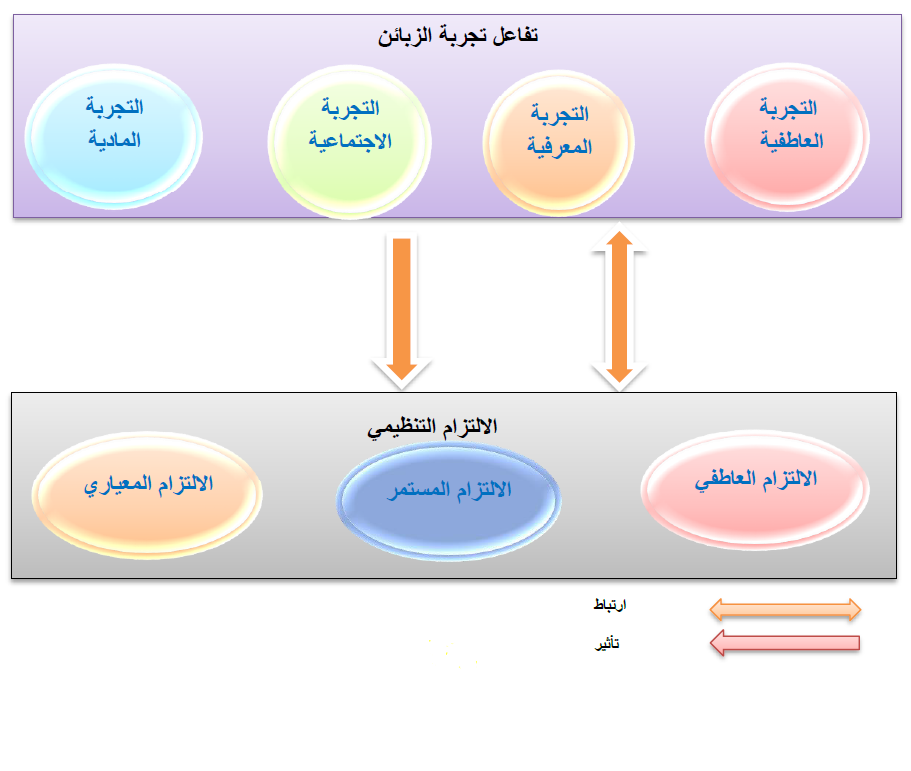Customer experience interaction and its role in organizational commitment
Analytical research for the opinions of a sample of workers in Noor Al-Kafeel Company
Keywords:
Customer experience interaction, organizational commitmentAbstract
The current research aims to know the relationship between customer experience interaction and its role in organizational commitment in (Noor Al Kafeel Company). A significant effect of customer experience interaction on organizational commitment, and accordingly, the research found many Conclusions and recommendations, the most important of which is that Noor Al-Kafeel Company cares about interacting with customers’ experience and works to achieve what they desire from products that suit all tastes, and provides a high organizational commitment for employees, which is reflected on their job satisfaction and creativity at work. They want new products that meet their needs and desires, which increases the company's productivity and achieves a sustainable competitive advantage.
References
سعيد , هديل كاظم , عبدالستار حلا صاحب ,2014"دور تبادلية القائد – العضو في سلوك المواطنة التنظيمية" بحث تحليلي في مركز وزارة الهجرة والمهجرين ,جامعة بغداد ,كلية الإدارة والاقتصاد , مجلة العلوم الاقتصادية والإدارية المجلد 41 العدد 87.
Ponsignon, F., Durrieu, F., & Bouzdine-Chameeva, T. (2017). Customer experience design: a case study in the cultural sector. Journal of Service Management.
Allen, N. J., & Meyer, J. P. (1990). The measurement and antecedents of affective, continuance and normative commitment to the organization. Journal of Occupational Psychology, 63(1).
Aycan, Z. (2004). Industrial/Organizational Psychology across Cultures.
Bagdare, S. and Jain, R. (2013), “Measuring retail customer experience”, International Journal of Retail and Distribution Management, Vol. 41 No. 10.
Brakus, J., Schmitt, B. and Zarantonello, L. (2009), “Brand experience: what is it? How is measured? Does it affect loyalty?”, Journal of Marketing, Vol. 73 No. 2.
Bustamante, J. C., & Rubio, N. (2017). Measuring customer experience in physical retail environments. Journal of Service Management.
Carlson, B.D., Suter, T.A. and Brown, T.J. (2007), “Social versus psychological brand community: the role of psychological sense of brand community”, Journal of Business Research, Vol. 61 No. 4.
Costa, P. L., Graça, A. M., Marques-Quinteiro, P., Santos, C. M., Caetano, A., & Passos, A. M. (2013). Multilevel research in the field of organizational behavior: An empirical look at 10 years of theory and research. Sage Open, 3(3).
Da Silva, R.V. and Syed, S.F. (2006), “Cognitive, affective attributes and conative, behavioral responses in retail corporate branding”, Journal of Product and Brand Management, Vol. 15 No. 5.
Darden, W. R., & Babin, B. J. (1994). Exploring the concept of affective quality: expanding the concept of retail personality. Journal of Business research, 29(2).
David, D., Miclea, M. and Opre, A. (2004), “The information-processing approach to the human mind: Basics and beyond”, Journal of Clinical Psychology, Vol. 60 No. 4.
Dhondt, S., Pot, F. D., & Kraan, K. O. (2014). The importance of organizational level decision latitude for well-being and organizational commitment. Team Performance Management.
Faloye, D. O. (2014). Organizational commitment and turnover intentions: Evidence from Nigerian paramilitary organization. International Journal of Business & Economic Development, 2(3).
Frey, L.L., Lee, J.E., McMulle, T.R. and Xia, T. (2010), “Relationships between maximum holding time and ratings of pain and exertion differ for static and dynamic tasks”, Applied Ergonomics, Vol. 42 No. 1.
Gaur, S.S., Herjanto, H. and Makkar, M. (2014), “Review of emotions research in marketing, 2002-2013”, Journal of Retailing and Consumer Services, Vol. 21 No. 6.
Gordon, S. J., Gardner, D. H., Weston, J. F., Bolwell, C., Benschop, J., & Parkinson, T. J. (2022). Using the critical incident technique to determine veterinary professional competencies important for enhancing the veterinarian‐client interaction. Veterinary Record, 190(6).
Groenesteijn, L., Ellegast, R.P., Keller, K., Krause, F. and De Looze, M.P. (2012), “Office task effects on comfort and body dynamics in five dynamic office chairs”, Applied Ergonomics, Vol. 43 No. 2.
Grundey, D., 2008. Editorial applying sustainability principles in the economy. Technol. Econ. Dev. Econ. 14 (2).
Gursoy, D., Chi, C. G. Q., & Karadag, E. (2013). Generational differences in work values and attitudes among frontline and service contact employees. International Journal of Hospitality Management, 32.
Idris, A. (2014). Flexible working as an employee retention strategy in developing countries: Malaysian bank managers speak. Journal of Management Research, 14(2).
Kang, D. S., Stewart, J. and Kim, H. (2011), “The effects of perceived external prestige, ethical organizational climate, and leader-member exchange (LMX) quality on employees' commitments and their subsequent attitudes”, Personnel Review, Vol. 40 No 6.
Kim, H. S., & Choi, B. (2016). The effects of three customer-to-customer interaction quality types on customer experience quality and citizenship behavior in mass service settings. Journal of Services Marketing.
Lemon, K. N., & Verhoef, P. C. (2016). Understanding customer experience throughout the customer journey. Journal of marketing, 80(6).
Lemon, K. N., & Verhoef, P. C. (2016). Understanding customer experience throughout the customer journey. Journal of marketing, 80(6).
Mahal, P. K. (2012). HR practices as determinants of organizational commitment and employee retention. IUP Journal of Management Research, 11(4).
Meyer, J. P., Stanley, D. J., Herscovitch, L., & Topolnytsky, L. (2002). Affective, continuance, and normative commitment to the organization: A meta-analysis of antecedents, correlates, and consequences. Journal of Vocational Behavior, 61(1).
OCass, A., 2004. Examining service experiences and post-consumption evaluations. J. Serv. Mark. 18 (6).
Singh, A., & Gupta, B. (2015). Job involvement, organizational commitment, professional commitment, and team commitment. Benchmarking: An International Journal, 22(6).
Tsai, Y., & Wu, S. W. (2011). Using internal marketing to improve organizational commitment and service quality. Journal of advanced nursing, 67(12.(
Verhoef, P. C., Lemon, K. N., Parasuraman, A., Roggeveen, A., Tsiros, M., & Schlesinger, L. A. (2009). Customer experience creation: Determinants, dynamics and management strategies. Journal of retailing, 85(1).
Villani, I. (2018). Transform Customer Experience: How to achieve customer success and create exceptional CX. John Wiley & Sons.
Von Gilsa, L., Zapf, D., Ohly, S., Trumpold, K., & Machowski, S. (2014). There is more than obeying display rules: Service employees’ motives for emotion regulation in customer interactions. European Journal of Work and Organizational Psychology, 23(6).
Yusnita, N., Gursida, H., & Herlina, E. (2022). The Role of Work-Life Balance and Job Satisfaction as Predictors of Organizational Commitment. Jurnal Economia, 18(1).

Downloads
Published
How to Cite
Issue
Section
License
Copyright (c) 2024 ياسمين قاسم الخفاجي

This work is licensed under a Creative Commons Attribution-NonCommercial-NoDerivatives 4.0 International License.
Authors retain the copyright of their papers without restrictions.









